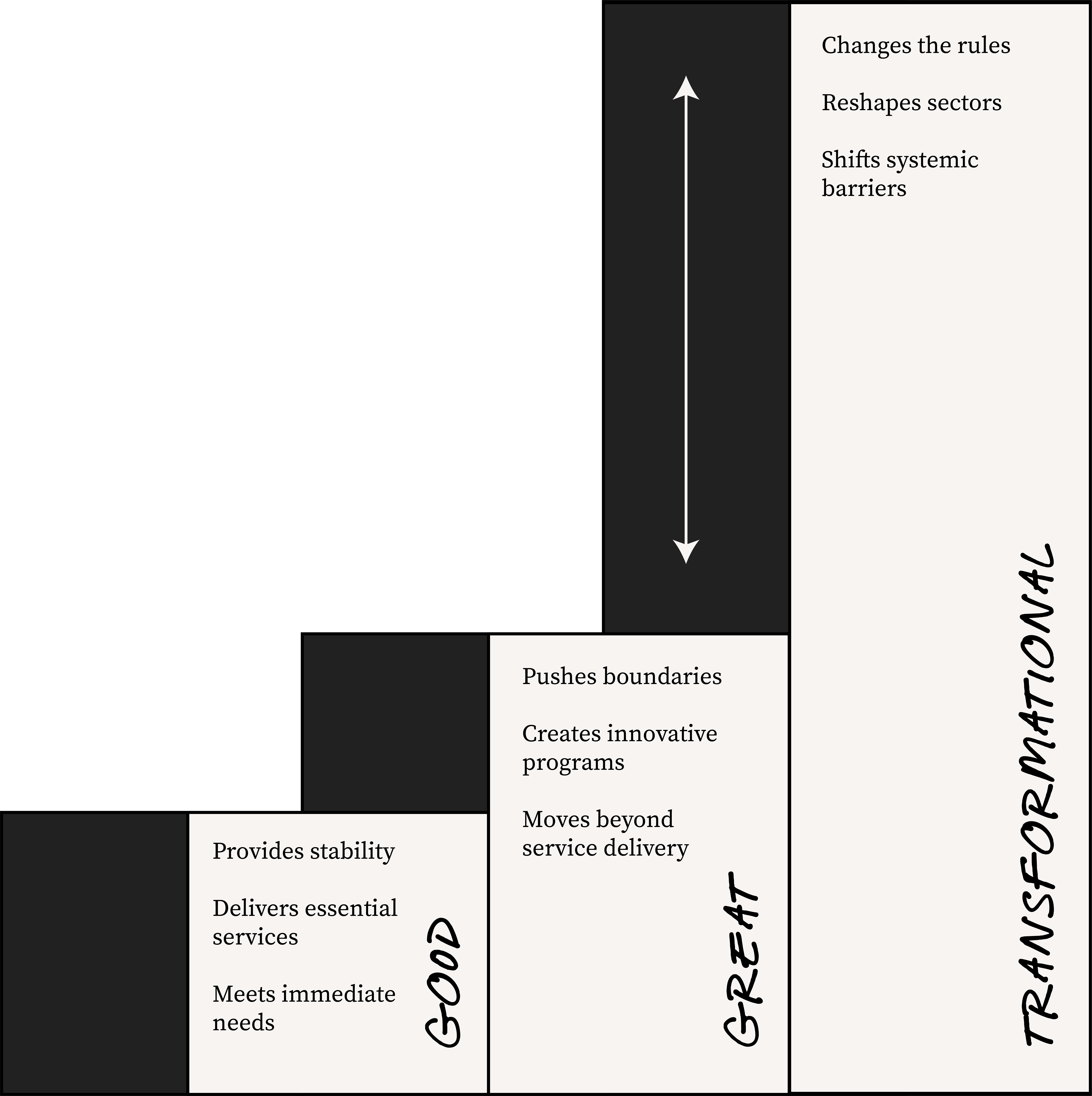Do You Want to Be Good, Great, or Transformational?
A few years ago, I was in a strategy conversation with a CEO when I asked them a question that stopped them in their tracks:
“Do you want to be good, great, or transformational?”
They paused for a long moment before answering.
“With the work we do and the inequities we’re trying to address, I don’t think we have any choice but to be transformational. But the truth is, we don’t know how to get there. Right now, we’re just hoping to get a little better every day.”

That conversation has stuck with me—not just because of what was said but also because of how common this tension is among leaders in the social impact space.
Every organization I work with wants to believe they are making a deep, systemic difference. Yet, when asked directly if they are being truly transformational, many hesitate. Not because they don’t want to be but because they are caught in the daily grind of operational demands, resource constraints, and short-term pressures.
Even organizations that consider themselves high-performing often realize they are making an impact but not fundamentally shifting the systems that create the challenges they are working to solve.
That is the difference between good, great, and transformational.
And in today’s world—where the stakes are higher than ever—being good or even great is no longer enough.
The Spectrum: Good, Great, or Transformational?
Organizations exist at different levels of impact, but the gap between being “great” and being “transformational” is larger than most people realize.
- Good organizations provide stability. They deliver essential services, keep programs running, and meet people’s immediate needs. They are reliable and necessary but often focus on treating symptoms rather than shifting underlying systems.
- Great organizations push boundaries. They set higher standards for effectiveness, create innovative programs, and move beyond service delivery into impact measurement. They challenge the status quo and continuously improve. Yet, many get stuck here—iterating on existing models rather than redefining what is possible.
- Transformational organizations do more than improve their own work; they reshape entire sectors, challenge systemic barriers, and fundamentally change the conditions that create inequity. They are not satisfied with addressing symptoms; they aim to shift power, policies, and structures so that the problems they were created to solve become obsolete.

The defining difference?
Transformational organizations change the rules of the game.
They don’t just succeed within the current system—they challenge and redesign it. And while it might seem like only the largest or best-resourced organizations can be truly transformational, that isn’t the case. Transformation isn’t a function of size or funding but of mindset, strategy, and operational design.
Transformation starts with a renewed belief in what’s possible. And that belief has to be backed up with intentional action. So why do so many organizations—even those with bold missions—struggle to make this leap?
Why So Many Organizations Get Stuck
1. Short-Term Thinking Reinforces Incrementalism
Many organizations, especially in the social impact, are funded and structured for incremental improvements, not systemic change.
They are incentivized to demonstrate quick wins and programmatic impact, which keeps them in a cycle of tweaking what exists rather than reimagining what’s possible.
This is reinforced by:
- Grant cycles that prioritize short-term outcomes over long-term transformation
- Boards that are risk-averse and focused on financial sustainability over mission alignment
- Leadership that is consumed by daily operations and lacks space to step back and rethink their approach
This isn’t a failure of leadership—it’s a failure of structure.
Organizations cannot operate like short-term businesses while trying to achieve long-term systemic change.
2. Leadership Development Focuses on the ‘Why’ Instead of the ‘What’
Most leadership development focuses on why transformation is important. Leaders hear inspiring messages about systems change, equity, and impact but are rarely equipped with the concrete operational shifts needed to make it happen.
Transformation isn’t about inspiration—it’s about execution.
Without clear, structural changes in how decisions are made, how talent is developed, and how teams are aligned, transformation remains an idea rather than a practice.
3. Culture Is Treated as a Set of Values, Not an Operating System
Many organizations talk about culture in terms of values, but culture is not what is written in a handbook—it is how work actually gets done.
Transformation isn’t about what an organization believes—it’s about how people collaborate, how decisions are made, and whether transparency and accountability are truly embedded.
This means looking at:
- How power is distributed within the organization
- How dissent and difficult conversations are handled
- Whether structures reinforce equity or unintentionally replicate exclusion
If culture doesn’t actively support bold action, it reinforces the status quo.
What It Takes to Be Transformational
Transformation doesn’t just happen because you want it to. It requires intentionality—especially when it comes to developing your organization from the inside out. You can’t just slap a new strategy over an old structure and expect different results. You need to take a hard look at how your organization is built, how it’s growing, and how it’s aligning with your transformational vision.
And here’s where it gets tricky: This isn’t just about checking off boxes on an organizational development plan.
It’s about ensuring that everything you’re building—your leadership, culture, and systems—supports long-term, sustainable growth. This is where the real work begins, and it’s why so many organizations get stuck in survival mode.
1. Re-Onboard Your Organization Every Year
Organizations spend a lot of time onboarding new hires. But how often do they re-onboard their entire workforce to the mission, strategy, and culture they must operate within?
Transformation isn’t a one-time decision—it requires continuous recalibration.
Each year, organizations should reset and realign around key questions:
- What external shifts demand that we rethink our approach?
- How do our decision-making structures reinforce or limit bold action?
- What behaviors, skills, and mindsets must we cultivate across teams?
Annual re-onboarding ensures that strategy is not something only executives understand—but something every team member is actively engaged in executing.
2. Hold Yourself Accountable for More Than Just Intentions
Organizations often set impact goals, but few create clear internal accountability structures to track whether they operate in a way that enables transformation.
Being transformational means setting measurable goals around:
- Power shifting: Are we creating conditions for shared leadership and decision-making?
- Culture alignment: Do our internal practices reinforce the transformation we want to see externally?
- Long-term outcomes: Are we designing solutions that will be sustainable, not just successful?
Accountability isn’t about perfection but ensuring alignment between vision and execution.
3. Invest in Leadership Alignment, Not Just Individual Leaders
Most organizations invest in individual leadership development but fail to align leadership teams around shared behaviors and decisions.
Transformational leadership isn’t about one inspirational CEO—it’s about a team that moves in sync toward systemic change.
This requires:
- Codifying how leadership makes decisions
- Aligning leadership incentives with long-term impact
- Building collective leadership capacity instead of over-relying on individual talent
An organization cannot be transformational if leadership is fragmented.
The Challenge for Leaders: Are You Ready to Leap?
As someone who has worked in the social sector for many years, I’ve often asked myself: Is good good enough? And in forcing myself to answer this, I’ve continuously come back to the same answer:
Good is good.
But it’s not good enough.
We owe it to the communities we serve to strive for transformational change, not just temporary solutions.
We have the opportunity, and I would argue, the obligation, to aim for something bigger. This doesn’t mean we abandon the good work we’re doing; rather, it means we expand upon it, building toward solutions that not only meet the immediate needs of the communities we serve but fundamentally change the systems that perpetuate those needs.
I also recognize that not every organization will become transformational.
That’s okay—there is value in being good and great.
But the truth is, most organizations have the potential to be transformational. The question is whether they are willing to:
- Rethink how they are structured to achieve their mission
- Challenge long-standing assumptions about how they operate
- Invest in leadership, culture, and talent in ways that create systemic change
So, I’ll ask you the same question I asked the CEO: Do you want to be good, great, or transformational?
Because the world isn’t asking us to tweak at the edges.
It’s asking us to lead.

